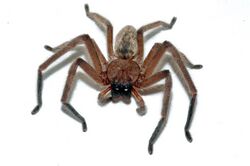Biology:Delena cancerides
| Delena cancerides | |
|---|---|

| |
| Illustration by Des Helmore | |
| Scientific classification | |
| Domain: | Eukaryota |
| Kingdom: | Animalia |
| Phylum: | Arthropoda |
| Subphylum: | Chelicerata |
| Class: | Arachnida |
| Order: | Araneae |
| Infraorder: | Araneomorphae |
| Family: | Sparassidae |
| Genus: | Delena |
| Species: | D. cancerides
|
| Binomial name | |
| Delena cancerides Walckenaer, 1837
| |
| Synonyms | |
| |
Delena cancerides, the communal huntsman, flat huntsman or social huntsman, is a large, brown huntsman spider native to Australia . It has been introduced to New Zealand, where it is sometimes known as the Avondale spider.[1] This was the species used in the Australian movie Napoleon and widely in Arachnophobia, and all films depict them as having a deadly venomous bite, but they are generally considered harmless to humans in real-life.[2] It was first described by Charles Athanase Walckenaer in 1837.[3]
Behaviour
Highly unusual among spiders, the flat huntsman spider is a social species, even sharing prey.[1] They are often found under loose bark (their flat shape is an adaptation for this) in colonies up to 300, but they are highly aggressive and commonly cannibalistic toward members from other colonies.[4] They hunt their food rather than spin webs for it. They are timid towards humans and bites are infrequent, and when they occur, symptoms are usually very minor.[5]
Distribution
The species is found all over Australia, including Tasmania. It was introduced to New Zealand in 1924. Its range in New Zealand expanded slowly out of Avondale, a suburb of Auckland, hence the alternative New Zealand common name.[1] There is a sculpture in the Avondale shopping centre celebrating the spider.
Appearance and genetics
Male D. cancerides have a body length of 20–25 millimetres (0.79–0.98 in), while females are larger, with a body length of 25–32 mm (0.98–1.26 in).[6] The body is light brown and covered in dense, fine hairs. The legs are also hairy, and can have a span of over 15 centimetres (5.9 in).[2]
Various populations show major differences in the chromosomes, leading to the recognition of several "chromosomal subspecies", but these hybridize where in contact and there is little genetic divergence.[1]
References
- ↑ 1.0 1.1 1.2 1.3 Rowell, D. M.; Avilés, L. (1995). "Sociality in a bark-dwelling huntsman spider from Australia, Delena cancerides Walckenaer (Araneae: Sparassidae)" (PDF). Insectes Sociaux (Basel, Switzerland: Birkhäuser) 42 (3): 287–302. doi:10.1007/BF01240423. ISSN 0020-1812. OCLC 260154986. http://domingo.zoology.ubc.ca/avileslab/reprints/InsSoc95.Delena.pdf. Retrieved 20 April 2012.
- ↑ 2.0 2.1 Hall, G.; Hoare, R.J.B.; Crosby, T.K (2001). "Avondale spider, our Hollywood star!". Insects and spiders of New Zealand/Aotearoa. Lincoln, New Zealand: Landcare Research. http://www.landcareresearch.co.nz/education/insects_spiders/facts/Avondale.asp.
- ↑ Platnick, Norman I. (10 December 2011). "Fam. Sparassidae". The World Spider Catalog, Version 12.5. New York, NY, USA: American Museum of Natural History. doi:10.5531/db.iz.0001. http://research.amnh.org/iz/spiders/catalog/SPARASSIDAE.html.
- ↑ Beavis, A. S.; Rowell, D. M.; Evans, T. (2007). "Cannibalism and kin recognition in Delena cancerides (Araneae: Sparassidae), a social huntsman spider" (PDF). Journal of Zoology 271 (2): 233–237. doi:10.1111/j.1469-7998.2006.00223.x. ISSN 0952-8369. OCLC 576114955. http://eligreenbaum.iss.utep.edu/Spider%20Cannibalism.pdf. Retrieved 20 April 2012.
- ↑ Museum Victoria. "Victorian Huntsman Spiders". Museum Victoria Discovery Centre. Melbourne, Australia: Museum Victoria. http://museumvictoria.com.au/discoverycentre/infosheets/spiders-found-in-victoria/victorian-huntsman/.
- ↑ Hawkeswood, Trevor J. (2003). "Delena cancerides Walckenaer, 1837". Spiders of Australia: an Introduction to Their Classification, Biology and Distribution. Pensoft series faunistica. 31. Sofia, Bulgaria: Pensoft. p. 87. ISBN 978-954-642-189-0. OCLC 440387624. https://books.google.com/books?id=7lFFAQAAIAAJ&q=cancerides. Retrieved 13 July 2012.
External links
| Wikimedia Commons has media related to Delena cancerides. |
- Avondale spider on the website of the Museum of New Zealand Te Papa Tongarewa
Wikidata ☰ Q1613086 entry
 |



